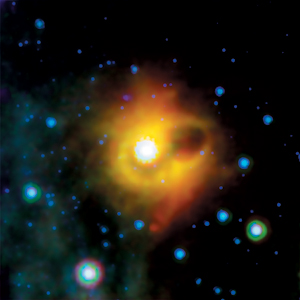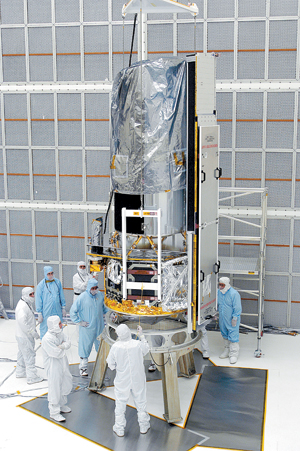|
|
|||
 |
About the Magazine | Advertising | Archives | Contact | ||
     |
|||
Next Generation
Ring of fire


In 2005 NASA’s Spitzer Space Telescope—the largest infrared telescope ever launched into space—detected a mysterious ring (top, right) encircling a dead star called SGR 1900+14. Two years later it picked up the ring again, and NASA scientist Stefanie Wachter recruited Chicago astrophysicist Vikram Dwarkadas to help decipher its origin.
Lodged within the Milky Way’s Aquila constellation, 20,000 light-years away from Earth, SGR 1900+14 is a magnetar, a compact cinder left behind after a core-collapse supernova. Possessing eight times the sun’s mass and intense, convulsive magnetic fields, magnetars occasionally unleash bursts of gamma rays and x-rays. That’s how SGR 1900+14 first came to scientists’ attention—on August 27, 1998, a powerful eruption of x-rays from the dead star showered Earth, stripping electrons from the atoms in the planet’s upper atmosphere. Astronomers have known about magnetars for 30 years, but never before, Dwarkadas said, have they seen one surrounded by a ring.
To make sense of the ring, Dwarkadas, Wachter, and five other researchers analyzed data from the Spitzer telescope. Peering past the dense gas and dust clouds that block optical telescopes, Spitzer (bottom, right, during a 2003 post-flight inspection at NASA’s Kennedy Space Center) picks up information about objects too dim to see with visible light. Because it uses infrared light, primarily composed of thermal radiation, the telescope must be cooled to near absolute zero to detect infrared signals from outer space without interference from its own heat.
In the May 29 Nature the researchers published their conclusions about SGR 1900+14’s ring. It was, they determined, formed during the convulsion. A powerful flare burst from the dying star, blasting into a nearby dust cloud and creating a ring that resembles “wind-blown bubbles and shells,” the coauthors wrote, and at its widest measures seven light-years across. Adjacent stars illuminate the ring. “It’s as if the magnetar became a huge flaming torch and obliterated the dust around it, creating a massive cavity,” coauthor and NASA astrophysicist Chryssa Kouveliotou said in a May news release. “Then the stars nearby lit up a ring of fire around the dead star, marking it for eternity.”